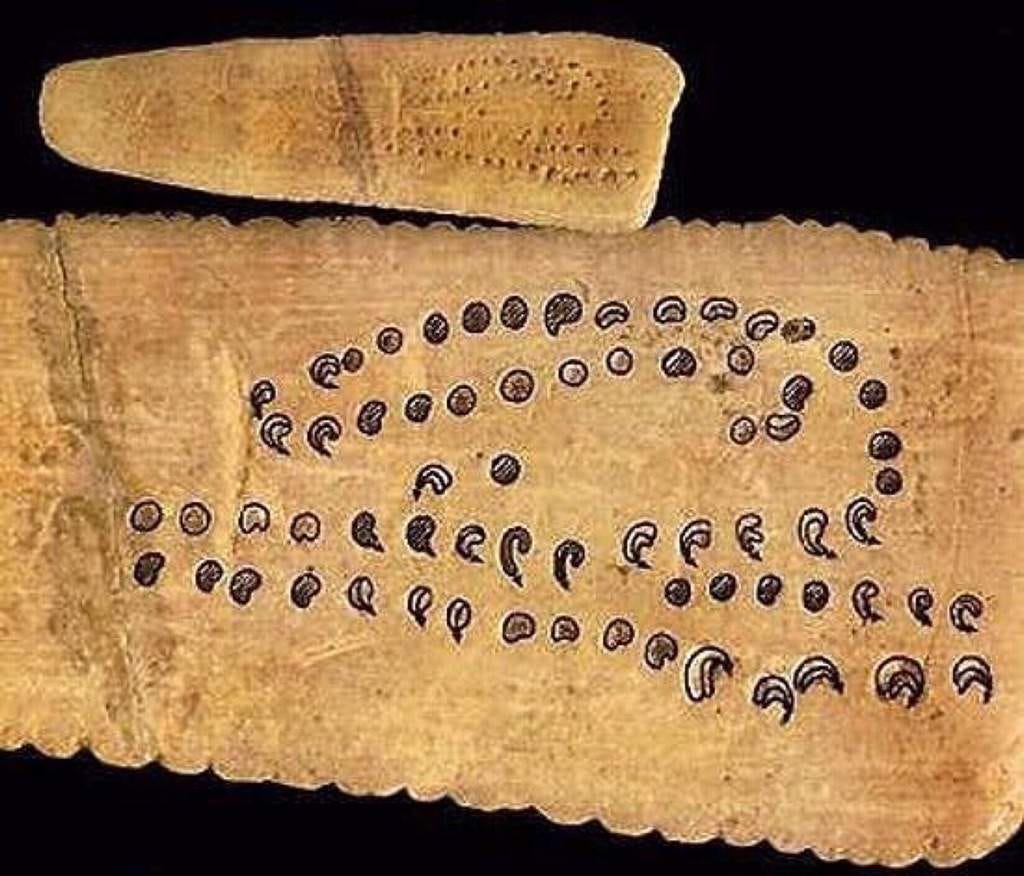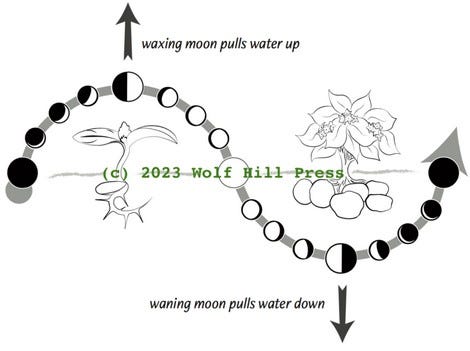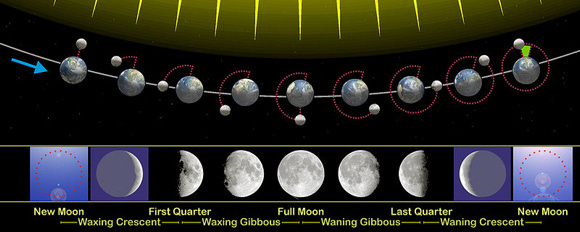When I was little, I loved looking at the nighttime sky. I had heard about heaven through childhood prayers, but didn’t yet know what the stars were. I developed my own reasoning. I thought that the sky was painted blue and that the stars were places where the paint had chipped off and the light of heaven was shining through. But the moon was a mystery. I had no explanation whatsoever for why it changed shape every night. I just called it the earth’s “nightlight.”
Phases of the Moon
Fast-forward several decades and I’m still learning about Earth’s satellite. Although the moon’s phases are now familiar, I confess I didn’t pay that much attention except maybe during full moons. I knew there was a pattern, but I didn’t know what it was - the moon just seemed to appear randomly in the sky. Once I committed to actually observing and tracking the moon, its cycles became more apparent.
For example, the moon orbits Earth counterclockwise. What phase it’s in and where you see it in the sky depends on where the sun is in relationship to the moon in space. When the moon is directly between Earth and the sun, it’s a new moon (left and right sides of graphic below). When the Earth is between the moon and the sun, it’s a full moon (middle of graphic). Other phases are determined by the moon’s other positions in relationship to the sun as the moon orbits the Earth.
Waxing and Waning
At the most basic level, the moon has two phases: waxing (getting “bigger”) and waning (getting “smaller”). Waxing occurs from the time of the new moon (which is not visible, as this is when the moon is between the earth and sun) to the time of the full moon (which is when the side of the moon that faces Earth is opposite the sun and fully illuminated). After the full moon, the moon begins to wane until it is no longer visible (dark moon) and the process begins again.
Four Quarters of the Moon: First Quarter, Full, Third Quarter, Dark/New
Breaking down the waxing and waning a bit further, there are four quarters - but the naming is a bit tricky. The first quarter and third quarter go by those names, but what about the other two? The “second quarter” is the full moon and the “fourth quarter” is the dark or new moon. It makes more sense if you consider the entire cycle. For example, at the first quarter moon, the moon is a quarter of the way through its cycle.
Further Divisions of the Moon Phases
In closer tracking of the moon’s phases, additional names are given to the moon in between the quarters:
Waxing Crescent: occurs between the new moon and first quarter.
Waxing Gibbous: occurs between the first quarter and the full moon. (The gibbous shape means “convex.”)
Waning Gibbous: occurs between the full moon and third quarter. (Also referred to as “disseminating.”)
Waning Crescent: occurs between the third quarter and the dark/new moon. (Also known as “balsamic.”)
The waxing and waning crescent moons have the same shape, but occur on different sides of the moon. The same is true for the waxing and waning gibbous moons. How to tell the difference when you see it in the sky? One mnemonic is “on the right, getting bright.” If you see a crescent shape on the right side of the moon, you’re looking at a waxing crescent moon. If it’s on the left side, it’s a waning crescent moon.
Following the Phases of the Moon
Through centuries of observation and experience, our ancestors understood and followed the cycles of nature. (It’s probably more accurate to say that our ancestors just intuitively followed the cycles. We haven’t always viewed ourselves as separate from or dominant over nature. Those ideas came later.)
Millenia before the widespread adoption of our current Gregorian calendar, our ancestors tracked time using the phases of the moon. (Some cultures still do.) More broadly, they based timekeeping on the seasons, or what was happening in nature. The moon’s phases were a reliable predictor for observances of celebrations, such as autumn harvest, which were also traditionally related to the seasonal changes.

Ancient cultures also needed a deep understanding of the moon’s phases and cycles to ensure their survival. For example, seafaring cultures knew the strongest tides followed the new and full moons. Likewise, agrarian societies depended on their knowledge of the moon phases for the successful planting and harvesting of crops. Before the theory of gravity explained the rising and falling of the water table, countless generations planted during the waxing moon (when the higher water table benefited seedlings and “above ground” plants) and focused on the roots during the waning moon (when the water table dropped, sending water down into plants’ roots).

To our ancestors, the moon was not just something beautiful to gaze upon. Through its predictable phases, the moon offered guidance and direction about life cycles. Each lunar cycle demonstrated a full process of creation/birth (new), growth (waxing), decline (waning), death and rebirth (dark/new). This process was deeply imprinted everywhere, and still is. The same life cycle could be seen in the four seasons: creation/birth (early spring), growth (late spring/summer), decline (autumn), death and rebirth (winter).
Because our ancestors viewed themselves as an integral part of the world around them, it seems — well, natural — that they would use/apply/live the same concepts in other aspects of their lives. So how might their intimate understanding of the moon phases have translated into other areas?
Below are meanings commonly attached to each moon phase in today’s lunar calendars. Notice how the moon phases synch up with the creation cycle. I’ve also overlaid the moon phases with the holy days marking the seasonal divisions of the Celtic Wheel. The Wheel is just one example of timekeeping that embeds the universal truth of the stages in a creation cycle, whether a plant or a project.
New Moon: Time of rebirth. What seeds (ideas/dreams) are starting to emerge? Begin to envision. (Winter Solstice to Imbolc)
Crescent: Time to tend. Nurture and focus. (Imbolc to Spring Equinox)
1st Quarter: Time to move. Take action. (Spring Equinox to Bealtaine)
Gibbous: Time to develop. Evaluate and refine. (Bealtaine to Summer Solstice)
Full: Time of ripeness. Embody and fulfill. (Summer Solstice to Lughnasa)
Disseminating: Time to harvest. Celebrate and share. (Lughnasa to Fall Equinox)
3rd Quarter: Time to release. Shed and pause. (Fall Equinox to Samhain)
Balsamic: Time to rest. Complete and reseed. (Samhain to Winter Solstice)
Dark: Time of stillness. Listen and observe. (Winter Solstice to Imbolc)
Of course, it’s not realistic to expect to align every “beginning” with the creation cycle of the moon phases. (Although I know that many people swear by setting their intentions for the next cycle at the new moon!) However, the phases are helpful reminders that:
Everything in life goes through this creation cycle: waxing/waning, light/dark, growing/shedding, acting/resting.
There is a flow to life. We can’t just stay in one phase that we prefer, such as always dreaming or always harvesting.
If we are aware of this flow, we can follow and honor wherever we are in the cycle.
Cycles are ongoing. If something doesn’t work out, a new beginning will be coming around soon.
Today, February 27, 2025 is the beginning of a new lunar cycle with the New Moon (in Pisces1). What seeds, ideas, projects are starting to emerge for you? This timing symbolizes one of many opportunities we have to begin again.
References, and for more information:
Ana V. Aceves (2016, July 6). What are the phases of the moon? Sky and Telescope. https://skyandtelescope.org/astronomy-resources/what-are-the-phases-of-the-moon/
Deborah Byrd (2023, January 1). 4 Keys to Understanding Moon Phases. Earthsky. https://earthsky.org/moon-phases/understandingmoonphases/
Griffith Observatory. (Retrieved 2025, February 20.) Moon Phases. Department of Recreation and Parks, City of Los Angeles. https://griffithobservatory.org/exhibits/ahmanson-hall-of-the-sky/moon-phases/
Lunar and Planetary Institute, Universities Space Research Association. (Retrieved 2025, February 20.) The Moon’s Influence on Us and About Our Seasons. https://www.lpi.usra.edu/education/solar-system/
University of Iowa, Department of Physics and Astronomy. (Retrieved 2025, February 20.) Imaging the Universe, Part 1: Lunar Phases. https://itu.physics.uiowa.edu/labs/observational/moon-and-telescopes-i/part-1-lunar-phases
Written February 2025.
Our ancestors also looked to the broader sky to orient themselves in space and time. “New Moon in Pisces” denotes both the moon phase (moon is between the sun and Earth) and the part of the sky where it occurs (Pisces constellation). Modern astronomers (still) use the ecliptic, or “the apparent path of the Sun across the celestial sphere over the course of the year”, as a celestial coordinate system for tracking objects in our solar system. The Pisces placement identifies when in the solar year the new lunar cycle is occurring.






